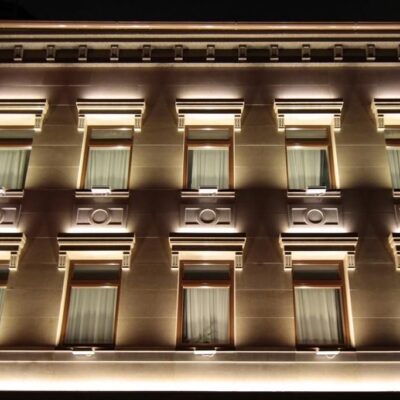ELECTRICAL FORMULAS
Demand for Power (kW) = System Input Wattage (W) ÷ 1,000
Energy Consumption (kWh) = System Input Wattage (kW) x Hours of Operation/Year
Hours of Operation/Year = Operating Hours/Day x Operating Days/Week x Operating Weeks/Year
Lighting System Efficacy (Lumens per Watt or LPW) = System Lumen Output ÷ Input Wattage
Unit Power Density (W/sq.ft.) = Total System Input Wattage (W) ÷ Total Area (Square Feet)
Watts (W) = Volts (V) x Current in Amperes (A) x Power Factor (PF)
Voltage (V) = Current in Amperes (A) x Impedance (Ohms) [Ohm’s Law]
ECONOMIC FORMULAS
Simple Payback on an Investment (Years) = Net Installation Cost ($) ÷ Annual Energy Savings ($)
5-Year Cash Flow ($) = 5 Years – Payback (Years) x Annual Energy Savings ($)
Simple Return on Investment (%) = [Annual Energy Savings ($) ÷ Net Installation Cost ($)] x 100
DESIGN FORMULAS
Footcandles & Lumens
Footcandles (fc) = Total Lumens (lm) ÷ Area in Square Feet
1 Lux (lx) = 1 Footcandle (fc) x 10.76
Lux = Total Lumens ÷ Area in Square Meters
Calculating Light Level at a Point
For planes perpendicular to the direction of candlepower (Inverse Square Law):
Footcandles (fc) = I ÷ D2
I = Candlepower in candelas (cd)
D = Direct distance between the lamp and the point where light level is calculated
Many workplanes are not perpendicular to the direction of light intensity, which is why calculating light level at a point is useful for such applications. In these cases, we often must determine light levels on workplanes that are not horizontal and perpendicular but tilted or even vertical. For tilted-horizontal or vertical planes:
Horizontal Footcandles (fch) = (I ÷ D2) x H
Vertical Footcandles (fcv) = (I ÷ D2) x L
I = Candlepower in candelas (cd)
D = Direct distance between the lamp and the point where light level is calculated
H = Distance between the lamp and the point direct below on the workplane
L = Distance between that point and the point where light level is being calculated
D = Square Root of (H2 + L2) or D2 = H2 + L2
Calculating Average Light Level Throughout a Space (three formulas)
Average Maintained Illumination (Footcandles) = (Lamps/Fixture x Lumens/Lamp x No. of Fixtures x Coefficient of Utilization x Light Loss Factor) ÷ Area in Square Feet
Average Maintained Illumination (Footcandles) = (Total Lamps x Lumens/Lamp x Coefficient of Utilization x Light Loss Factor) ÷ Area in Square Feet
Average Maintained Illumination (Footcandles) = (Lamps in One Fixture x Lumens/Lamp x Coefficient of Utilization x Light Loss Factor) ÷ Area in Square Feet/Fixture
Lumen Method
Required Light Output/Fixture (Lumens) = (Maintained Illumination in Footcandles x Area in Square Feet) ÷ (Number of Fixtures x Coefficient of Utilization x Ballast Factor x Light Loss Factor)
Light Loss Factors (more on Light Loss)
Light Loss Factor (LLF) = Ballast Factor x Fixture Ambient Temperature Factor x Supply Voltage Variation Factor x Lamp Position Factor x Optical Factor x Fixture Surface Depreciation Factor x Lamp Burnouts Factor x Lamp Lumen Depreciation Factor x Fixture Dirt Depreciation Factor x Room Surface Dirt Depreciation Factor
Lamp Burnout Factor = 1 – Percentage of Lamps Allowed to Fail Without Being Replaced
Zonal Cavity Method (determining cavity ratios)
Room Cavity Ratio (for regular rooms shaped like a square or rectangle) = [5 x Room Cavity Depth x (Room Length + Room Width)] ÷ (Room Length x Room Width)
Room Cavity Ratio (for irregular-shaped rooms) = (2.5 x Room Cavity Depth x Perimeter) ÷ Area in Square Feet
Ceiling Cavity Ratio = [5 x Ceiling Cavity Depth x (Room Length x Room Width)] ÷ (Room Length x Room Width)
Floor Cavity Ratio = [5 x Floor Cavity Depth x (Room Length x Room Width)] ÷ Room Length x Room Width
Room surface reflectances can be predicted in a new design or measured in an existing facility. If existing facility:
Room Surface Reflectance (%) = Reflected Reading ÷ Incident Reading
Reflected Reading = Measurement from a light meter holding it about 1.5 feet away from the surface with the sensor parallel and facing the surface.
Incident Reading = Measurement from a light meter held flat against the surface and facing out into the room.
Calculating Number of Lamps And Fixtures And Spacing
Required No. of Fixtures = (Lumens/Lamp x No. of Lamps x Coefficient of Utilization x Light Loss Factor x Area in Square Feet) ÷ (Lumens/Lamp x Lamps/Fixture x Coefficient of Utilization x Light Loss Factor)
Required Lamps = Required Lumens ÷ Initial Lumens/Lamp
Maximum Allowable Spacing Between Fixtures= Fixture Spacing Criteria x Mounting Height
Fixture Spacing Criteria: See the manufacturer’s literature
Mounting height: Distance in feet between the bottom of the fixture and the workplane
Spacing Between Fixtures = Square Root of (Area in Square Feet ÷ Required No. of Fixtures)
Number of Fixtures to be Placed in Each Row (Nrow) = Room Length ÷ Spacing
Number of Fixtures to be Placed in Each Column (Ncolumn) = Room Width ÷ Spacing
For the above two formulas, round results to the nearest whole integer.
Spacingrow = Room Length ÷ (Number of Fixtures/Row – 1/3)
Spacingcolumn = Room Width ÷ (Number of Fixtures/Column -1/3)
If the resulting number of fixtures does not equal the originally calculated number, calculate impact on the designed light level:
% Design Light Level = Actual No. of Fixtures ÷ Originally Calculated No. of Fixtures
To calculate fixtures mounted in continuous rows:
Number of Luminaires in a Continuous Row = (Room Length ÷ Fixture Length) – 1
Number of Continuous Rows = Total Number of Fixtures ÷ Fixtures Per Row
MAINTENANCE
Lamp Life
Calendar Lamp Life (Years) = Rated Lamp Life (Hours) ÷ Annual Hours of Operation (Hours/Year)
Lamp Burnout Factor
Lamp Burnout Factor = 1 – Percentage of Lamps Allowed to Fail Without Being Replaced
Group Relamping Cost
Annualized Cost ($) = A x (B + C)
A = Operating Hours/Year ÷ Operating Hours Between Relampings
B = (Percentage of Lamps Failing Before Group Relamping x Number of Lamps) x (Lamp Cost + Labor Cost to Spot Replace 1 Lamp)
C = (Lamp Cost, Group Relamping + Labor Cost to Group Relamp 1 Lamp) x Number of Lamps
Spot Relamping Cost
Average Annual Cost ($) = (Operating Hours/Year ÷ Rated Lamp Life) x (Lamp Cost + Labor Cost to Replace 1 Lamp) x Total Number of Lamps



